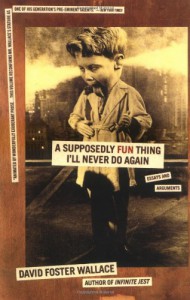A Supposedly Fun Thing I'll Never Do Again: Essays and Arguments

"a Kilroyishly surreal quality"
...I fell for DFW in the footnotes.
How was I to know? I don't read footnotes. When I edited a couple of books, I told the contributors, in draconian terms, that if the information wasn't important enough to include in their main text, delete the footnote; if it was, incorporate it into the main text.
Wallace puts many of his best lines, and a lot of himself, in his footnotes. They form a sort of counter-essay, hunkering below and complicating the essay above. When I initially read the book's title essay, true to form, I skipped the footnotes. I was ready to hurl the book after the chess-match description. Repeatedly, Wallace reminds us what a good chess player he is, and offers up the information that he didn't even start playing chess until he was in his late twenties. Apparently, this late start is more genuine than that of the nine-year-old girl who defeats him. Her talent, somehow genetic and mechanical, is lifeless and urged into motion by her hateful stage mother. I wanted to yell, "Oh shut up, man up, and get over it. The little girl beat your pants off." Of course in the footnote, countering Wallace's seemingly insufferable behavior, is the comment "only Deirdre's eyes and nose clear the board's table as she sits across from me, adding a Kilroyishly surreal quality to the humiliation" (326).
This is funny stuff, and Wallace underscores his appreciation for the absurdity in a later footnote: "103 - I've sure never lost to any prepubescent females in fucking Ping-Pong, I can tell you" (328).
The alternate "footnotes' essay" of the essay entitled "Tennis Player Michael Joyce's..." beats the main essay hands down. As a former, quite crappy, tennis player, I recall watching some of the players he describes, though not Michael Joyce. That ignorance, however, does not lessen the hilarity of footnote no. 18:
Joyce is even more impressive, but I hadn't seen Joyce yet. And Enqvist is even more impressive than Joyce, and Agassi live is even more impressive than Enqvist. After the week was over, I truly understand why Charlton Heston looks gray and ravaged on his descent from Sinai: past a certain point, impressiveness is corrosive to the psyche." (224)
And then there's this razor-sharp snapshot of McEnroe, whom I do recall watching, in footnote no. 30:
John McEnroe wasn't all that tall, and he was arguably the best serve-and-volley man of all time, but then McEnroe was an exception to pretty much every predictive norm there was. At his peak (say 1980 to 1984), he was the greatest tennis player who ever lived--the most talented, the most beautiful, the most tormented: a genius. For me, watching McEnroe don a polyester blazer and do stiff lame truistic color commentary for TV is like watching Faulkner do a Gap ad." (230)
OTOH, Wallace's dissection of a moderately revised Ph.D. dissertation in the essay, "Greatly Exaggerated," is the sort of shooting fish in the barrel, beneath his talents' stuff that I decried in my original review below, and the title essay, though now beloved by me, is still riddled with death - from his description of the preternatural cleanliness of the ship, hiding the inevitable decay, to the disturbingly electric blue Caribbean sky.
However, I'm ready to go back to Infinite Jest, with far more loving thoughts toward DFW, a fellow agoraphobe.
...Unfortunately, I can't read the teeny font in his opus, and the print in the footnotes is even teenier. I'm accepting donations for a Kindle DX, 9.7" display, $489.
* * * * * *
original rant
David Foster Wallace may tip me over the brink. 160 or so pages into his opus, IF, I decided that the book was in jest, infinitely, and I wasn't going to participate in the joke. I've just finished the title essay from his collection A Supposedly Fun Thing I'll Never Do Again and while I found much of it engaging, like a high wire act, virtuoso performances engage only so long.
I'm trying to determine why DFW elicits so much irritation. He's only 33 when he writes this essay about his cruise experience, but his death is riddled throughout the narrative. I may be succumbing to what Jean-Paul Sartre said about how, once lived. we read a life backwards (I need to look this up - Sartre wrote this more eloquently).
Despite that bit of poignancy, most of the time I'd like to reach through the pages and slap DFW. His view, so often, is from on high. He looks down from the high deck at the tourists disgorging from the ship to see the sights. He takes such pains not to be one of the ridiculous American tourists he mocks, and yet, he's a little ridiculous himself - primarily camped out in Cabin 1009, with the exception of the moments he takes mental snapshots of the "others" as surely as if he used a camera, which he reminds us at least three times, he does not use, the camera being such a touristy icon and all.
Perhaps it's all this prodigious talent being wasted on taking potshots at the inanity of a cruise trip - while his snarky comments are often dead on accurate and occasionally hilarious; these glossy surfaces must have been child's play for him. He mocks the commercial-essay Frank Conroy produces for the cruise ship, but DFW may be providing only the photo-negative.




